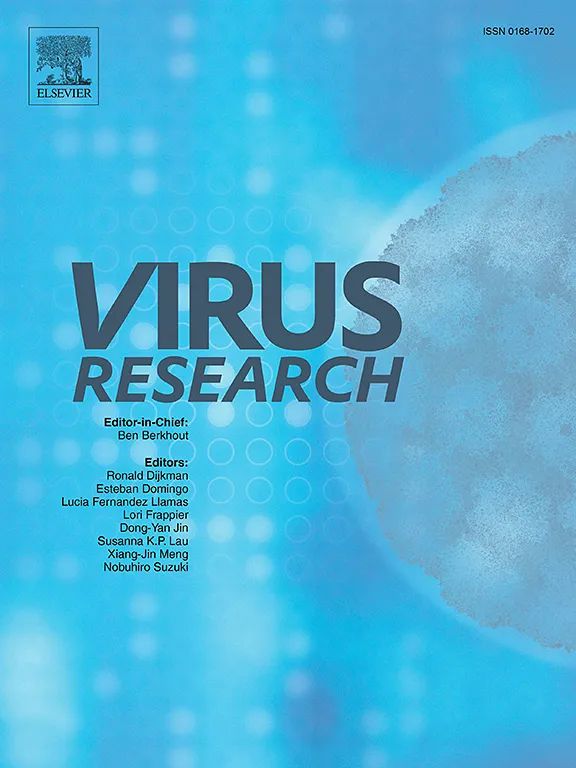Transcriptomic insights into host transcriptional manipulation by ssDNA and ssRNA viruses in the marine planktonic diatom Chaetoceros tenuissimus
IF 2.7
4区 医学
Q3 VIROLOGY
引用次数: 0
Abstract
The marine diatom Chaetoceros tenuissimus coexists in the coastal ocean with two distinct viruses: a circular single-stranded DNA virus and a single-stranded RNA virus. Both viruses are capable of killing the host in vitro experiments; however, the molecular mechanisms by which host genes respond and are utilized by these viruses for replication and proliferation remain unclear. In this study, RNA-seq analyses were conducted to investigate these mechanisms, and the host transcripts specific to each virus were validated by RT-qPCR. In the early phase of infection, RNA-seq analysis revealed that gene transcription related to endocytosis, vacuolar acidification, and nitrogen metabolism was commonly upregulated. In contrast, genes related to transcription and translation were downregulated in cells inoculated with the DNA virus. In the later phase of infection, cells inoculated with the DNA and RNA viruses showed upregulation of genes related to DNA replication and packing, and autophagy, respectively. These virus-specific gene transcripts were confirmed to differ significantly by RT-qPCR. Chaetoceros tenuissimus has previously inserted a fragment of the DNA viral gene (EVLF) into its genome. Intriguingly, the transcription level of EVLF was upregulated in cells inoculated with the DNA virus as time progressed. Thus, regarding specific molecular responses, the DNA virus may hijack the host replication machinery to replicate its own genome, with EVLF playing a role in viral proliferation, whereas the RNA virus may hijack the autophagosome membrane to replicate its own genome, based on the observed replication of the related RNA virus at the membrane. This fundamental information provides insight into the diatom–virus infectious mechanism.
海洋浮游硅藻中ssDNA和ssRNA病毒对宿主转录操作的转录组学见解。
海洋硅藻与两种不同的病毒共存于沿海海洋:一种环状单链DNA病毒和一种单链RNA病毒。在体外实验中,这两种病毒都能杀死宿主;然而,宿主基因反应的分子机制以及这些病毒利用宿主基因进行复制和增殖的机制尚不清楚。在本研究中,我们通过RNA-seq分析来研究这些机制,并通过RT-qPCR验证了每种病毒特异性的宿主转录本。在感染早期,RNA-seq分析显示,与内吞作用、空泡酸化和氮代谢相关的基因转录普遍上调。相反,在接种DNA病毒的细胞中,与翻译相关的基因被下调。在感染后期,接种了DNA和RNA病毒的细胞分别表现出DNA复制和包装相关基因和自噬相关基因的上调。这些病毒特异性基因转录物通过RT-qPCR证实有显著差异。在此之前,细毛毛藻已经将一段DNA病毒基因(EVLF)插入到其基因组中。有趣的是,随着时间的推移,接种DNA病毒的细胞中EVLF的转录水平上调。因此,对于特定的分子反应,DNA病毒可能劫持宿主的复制机制来复制自己的基因组,其中EVLF在病毒增殖中起作用,而RNA病毒可能劫持自噬体膜来复制自己的基因组,基于观察到相关RNA病毒在膜上的复制。这一基本信息提供了对硅藻病毒感染机制的深入了解。
本文章由计算机程序翻译,如有差异,请以英文原文为准。
求助全文
约1分钟内获得全文
求助全文
来源期刊

Virus research
医学-病毒学
CiteScore
9.50
自引率
2.00%
发文量
239
审稿时长
43 days
期刊介绍:
Virus Research provides a means of fast publication for original papers on fundamental research in virology. Contributions on new developments concerning virus structure, replication, pathogenesis and evolution are encouraged. These include reports describing virus morphology, the function and antigenic analysis of virus structural components, virus genome structure and expression, analysis on virus replication processes, virus evolution in connection with antiviral interventions, effects of viruses on their host cells, particularly on the immune system, and the pathogenesis of virus infections, including oncogene activation and transduction.
 求助内容:
求助内容: 应助结果提醒方式:
应助结果提醒方式:


